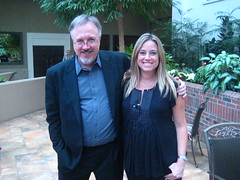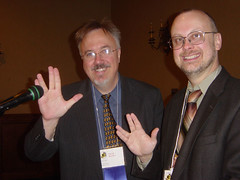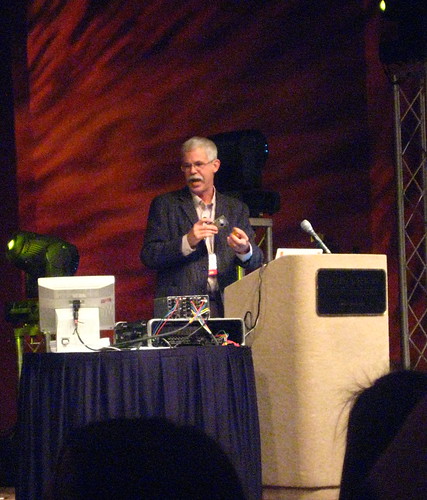Thursday was an incredible day in London. Not only did I get to work in Ontario with such hospitable people, especially Doug Pederson (thanks for the cab fare, bro), meet and get my picture taken with Amber MacArthur, and meet her fiancé, Chris — but I also got to meet two edublogger greats, Rodd Lucier (The Clever Sheep) and Quentin D’Souza (Teaching Hacks). Come on back, D’Souza. It’s a great blog.
 |
| Trying to help Amber feel less conscious of her pregnant belly |
|
In his blog post on Friday (Fertilizing the Grass Roots), Rodd wrote:
At today’s Western RCAC Symposium, educators from across southwestern Ontario were called to engage with emerging tools in order to ensure learning is relevant to 21st Century learners.
He went on to say,
My personal suspicions are that most attendees will fail to make effective use of any of the many tools introduced today. Even with everyone recognizing that we have a long way to go: A significant knowing-doing gap will remain!
Then Rodd listed some comments that he overheard during the conference, that support his concern. I’m listing them here and will try to make some suggestions that may be useful. My suggestions are indented just a bit to better distinguish them from the overheard statements.
Comment 1: “Our IT department won’t let us!”
Granted, it’s easy for me to say that IT should work for you, the teachers. Their job is to make sure that you, the teachers, can do what you want to do — not prevent it. Getting them to realize this is the challenge. One of the best suggestions I’ve heard was when a tech director suggested that IT folks be required to follow students around for a day. I would suggest that IT folks be required to sit in a classroom for a day, each month or so, to see not just the challenges of teaching, but the passion of mission. We need to bring them into the mission.
I suspect that IT folks are evaluated each year just like teachers. Give them an instructional goal to accomplish each year, find some way to technically facilitate better reading, global awareness, creativity, etc.
One final idea. When you submit a request for technical service in writing, include a statement of it’s instructional benefit or goal, and write it clearly, succinctly, yet prominantly. This way, refusing the request is documented as preventing instructional activities — and fulfilling the request makes you partners in a holy cause.
Comment 2: “My superintendent doesn’t get it.”
Suggest that your superintendent read “The World is Flat.” I don’t agree with everything that Freedman says in the book, and some of it has been debunked. Yet, this book has probably had a larger influence on our rethinking our place in a rapidly changing world than any other message. You might start with your principal and work your way up.
Enlist your students. Help them make (our get out of their way) public service announcement videos expressing the importance of digital networked learning in an increasingly global marketplace.
Organize a 21st century education fair, arranging for teachers and students to demonstrate what they are doing with contemporary information technologies. Invite vendors to bring in interactive white boards, turn the kids loose on them. Invite the local paper, radio, and television stations, and allow students to organize booths where they can demonstrate what they are doing with technology and information outside the classroom, i.e. video games, social media, and social networking.
Comment 3: “We don’t have enough money.”
True enough. But I’m starting to wonder whether technology might be a cheaper way to do things. Find out how much you’re paying for paper and printing. Find out how much it costs to heat your buildings each day. Find out how much you spend on textbooks, that are produced by 15th century technology.
Then, what would be the cost of equiping all teachers with a state of the art notebook computer, every student with a netbook, integrate virtual learning environments, and establish a consortium of schools where teachers would collaborate to create a dynamic, customizable, digital networked textbook — available for free to the entire province and beyond.
Comment 4: “Our computers are too old.”
Your computers may be too old to run MS Office 2007 or Photoshop, but probably not too old to run, through Firefox, Google Docs and and a growing array of cloud applications. One young man, at the conference, talked about bringing in older donated computers, having his students refurbish them, and then install Ubuntu Linux, giving them an equal array of opensource software — and the cloud.
Comment 5: “The school networks are out of date.”
Well this is a problem. It seems that Alberta has established fibre to every school in the province, recognizing the critical importance of the Internet to teaching and learning. This is something that has to be accomplished from the top — connection to contemporary, digital, networked, and abundant information is as critical to education today as heat and electricity.
Comment 6: “We still ban cell phones in school!”
This is simply not one of the wagons I’m riding. I think that it will come, that we’ll recognize the value of pocket-based information technologies in education as we stop being afraid and come to respect what our students are doing with them outside the classroom.
But I’d not focus on cell phones. I do not believe that we should expect our children to learn about the world through a keyhole. They need larger windows on the world, more powerful lenses. We would never think of issuing textbooks the size of a matchbook.
If we’re working toward preparing our children for their (and our) future, then we can’t compromise on content space.
Comment 7: “I’ve never even heard of RSS.”
Well, my initial response is, “Why not?” I think that we have to stop excusing educators from not keeping up with what’s happening around them. It’s what’s wrong with Prenski’s otherwise brilliant distinguisher, Digital Natives and Digital Immigrants. It can be an excuse for immigrants to say, “I can’t learn that. I’m not a native.”
As I said in the PLN session, “Start small.” Form study groups, set teachers up with RSS Readers (you don’t have to use the term RSS). Suggest a few connections for them, and have them blog (again, you don’t have to call it a blog if that will help) to each other what they’re learning. You have to start the connections. You have to start the conversations. You have to work toward the point to where the learning engine kicks in, and starts running on its own momentum.
Comment 8: “The kids know more than we do.”
No they don’t. They are more savvy at using technology, but we are better at using information. They know how to play the information. They desperately need us to teach them to work the information.
It’s one of the benefits of redefining teachers as Master Learners, that it give us permission to say, “Can you teach me how to do that with a digital camera?”
Comment 9: “I don’t have the time!”
This is too true. When Amber MacArthur interviewed me for her podcast after her keynote, lack of time is the barrier to retooling classrooms that I zero’ed in on. The teacher-day is virtually unchanged from the classrooms I attended in the ’50s and ’60s. Think of lawyers, surgeons, or even farmers. Do they spend all of their time in front of juries, in operating rooms, or in the fields. No! An important part of their job is research, collaboration, reflection, resource development, and professional development.
Now think of factory workers, who spend all of their time on the assembly line, installing parts. And think of teachers, spending all their time with students on a conveyor belt, moving through kindergarten, 1st grade, 2nd grade, while we install math on them, reading, science… Education is still an industrial age institution, trying to address information age problems.
This is a tough one, but, as you publish information about your schools, and take pictures of teachers on the job — include lots of pictures of teachers researching, collaborating, engaged in professional development, liaising with the community. These are all critical elements of being a teacher today. We have to get that message out there.
 I’ve confessed before that I am an iPhone Apps junkie, and that my favorite app, at least the one I dial to first, is Mobile News “Powered by Associated Press.” This morning, at 5:00 AM, I wasn’t very happy with this app, as I learned that Barack Obama will likely choose Chicago schools chief, and Obama basketball buddy, Arne Duncan. The consolation is that it could have been much worse — small consolation, though plodding down the same tired and terrible road is not so much a certainty, as it might have been.
I’ve confessed before that I am an iPhone Apps junkie, and that my favorite app, at least the one I dial to first, is Mobile News “Powered by Associated Press.” This morning, at 5:00 AM, I wasn’t very happy with this app, as I learned that Barack Obama will likely choose Chicago schools chief, and Obama basketball buddy, Arne Duncan. The consolation is that it could have been much worse — small consolation, though plodding down the same tired and terrible road is not so much a certainty, as it might have been.







 I’m sitting here watching Jim Moulton’s keynote. I’m also reading Jeff Whipple’s twittering of Zhao’s keynote in New Hampshire (where I was yesterday) — and still preparing for my three presentations and one workshop today. …and I can’t multitask.
I’m sitting here watching Jim Moulton’s keynote. I’m also reading Jeff Whipple’s twittering of Zhao’s keynote in New Hampshire (where I was yesterday) — and still preparing for my three presentations and one workshop today. …and I can’t multitask.